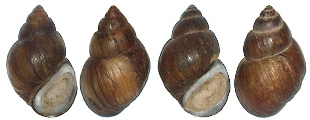Predator/Prey Interactions
University of Wisconsin-Madison limnologist David
B. Lewis conducted a study of predator prey interactions between freshwater snails
and Crayfish. His work was published in, Trade-Offs Between
Growth And Survival:
Responses Of Freshwater Snails To
Predacous Crayfish (Lewis, 2001). Lewis' snail of choice
to study this interaction was Amnicola limosa. Two
questions where posed by Lewis, one "whether the habitat
association of snails is influenced by Crayfish, owing either to
a behavioral response or to differential vulnerability among
habitats. Second, I examine whether the growth of snails is
affected by their responses to predation risk from Crayfish
(Lewis, 2001)."
And Survival:
Responses Of Freshwater Snails To
Predacous Crayfish (Lewis, 2001). Lewis' snail of choice
to study this interaction was Amnicola limosa. Two
questions where posed by Lewis, one "whether the habitat
association of snails is influenced by Crayfish, owing either to
a behavioral response or to differential vulnerability among
habitats. Second, I examine whether the growth of snails is
affected by their responses to predation risk from Crayfish
(Lewis, 2001)."
Lewis observed that snails live more on bottom
sediments where food is more plentiful when lakes
lack abundant Crayfish populations
(Lewis, 2001).
In lakes with abundant Crayfish populations snails
tended to crawl up vegetation and other such
elevated objects where food was scarce to avoid
predation. He also observed that more snails
survived in habitats with abundant crawl up area than
habitats with no or little crawl up area
(Lewis,
2001). His experiments backed his observations
and he came to the conclusion that, "Crayfish likely
impose a growth cost on snails through both direct
and indirect pathways (Lewis, 2001)." They do
this by scaring snails vertically where they are not
allowed to forage freely.


In one of his experiments entitled, "Differential Mortality", he compared A. limosa to Campeloma crassula (because of there similar morphologically but differing size, C. crassula being much larger) to, "Infer whether field patterns of snail distribution could derive from differential vulnerability among habitats (Lewis, 2001)."
